Sartana, Ukraine
Sartana (Ukrainian/Russian: Сартана; Greek: Σαρτανάς or Σαρτανά, known as Primorskoe from 1938 to 1990) is an urban-type settlement on the banks of the river Kalmius in Donetsk oblast, eastern Ukraine. It was administratively part of the Kalmiuskyi District before 2020, and is now part of Mariupol Raion, and the settlement has close proximity to the city of Mariupol. The name of the village means "yellow calf" (sary - yellow, tana - calf) in the Urum language. Of the population of the settlement, about 10,070 (2022 estimate),[1] the majority is ethnic Greek and speak the Greek language fluently.[2]
Sartana
Сартана | |
|---|---|
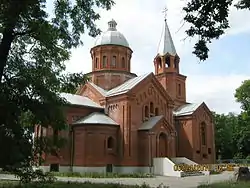 St. George's Church | |
 Coat of arms | |
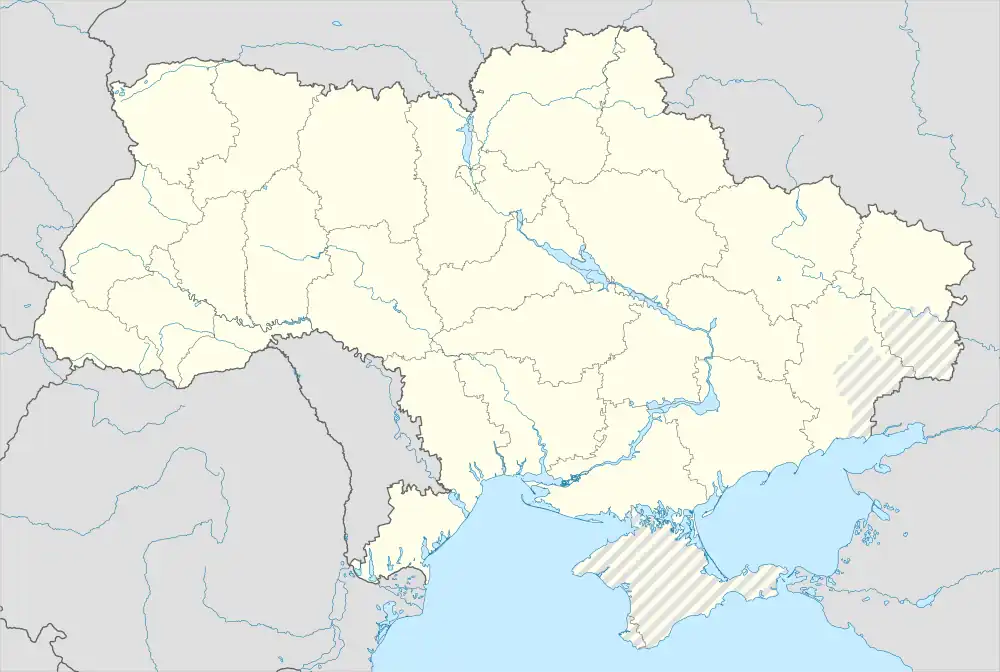 Sartana Location of Sartana in Donetsk Oblast 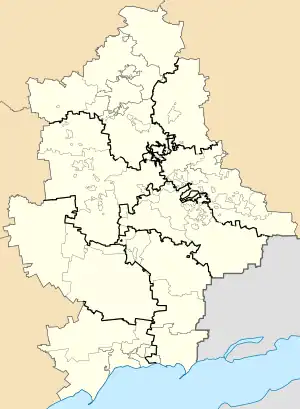 Sartana Sartana (Donetsk Oblast) | |
| Coordinates: 47°10′00″N 37°41′00″E | |
| Country | |
| Oblast | |
| Raion | Mariupol Raion |
| Hromada | Sartana settlement hromada |
| Founded | 1780 |
| Area | |
| • Total | 6.75 km2 (2.61 sq mi) |
| Population (2022) | |
| • Total | 10,070 |
| • Density | 1,500/km2 (3,900/sq mi) |
| Time zone | UTC+2 (MSK) |
| • Summer (DST) | UTC+3 |
| Postal code | 87592, 87593 |
| Area code | +380 629 |
History
The village was founded in 1780 by Urum Greeks, resettled by the Russian government from the village of the same name in the mountainous Crimea during the Emigration of Christians from the Crimea in 1778. The resettlement was initiated by a decree signed by Catherine the Great in 1779, which is kept in the Mariupol Museum of Local Lore. The decree included the transportation of the Greek population, as well as special privileges for the establishment of agriculture, fisheries, trade and industry. One of the pioneers was Archbishop Ignatius, and about 19,000 Greeks moved with him.[2]
In 1807, Mariupol and the surrounding Greek villages were recognised as an independent administrative unit, with an exclusively Greek population.[2] In 1824, a stone church was built in the town in honor of the Holy Great Martyr George the Victorious in the tradition of Greek architecture.[3] From 1825 to 1831, the Mariupol Theological Seminary operated in the village. In 1898, the Belgian company SA Providence Russe opened a steelworks in Sartana, now the Ilyich Steel & Iron Works.[4]
In 1935, the Greek folk song and dance ensemble, “The Diamonds of Sartana”, was founded in Sartana, and became popular across Ukraine and in Moscow.[2] In 1936, the ensemble took first place in the All-Union Review of National Minority Groups in Moscow, but was forced to close in 1937 due to political repressions. In 1967, through the efforts of Maria Gaitan and other enthusiasts, it was recreated under the name "Sartana Gems" and became the leading Greek group of the Sea of Azov and Ukraine.[5]
From 1938 to 1990, the town was named Primorskoe.[6]
In 1987, the Museum of the History and Ethnography of the Greeks of the Azov Sea Region was founded in the village.[7]
| Museum of the History and Ethnography of the Greeks of the Azov Sea Region | 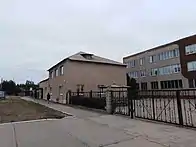 |
 |
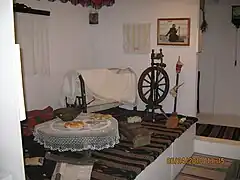 |
On March 6, 2004, a broiler factory was opened in Sartana. In 2005, a new church of St. George the Victorious was built.[3] In 2014 and 2015, during the armed conflict in eastern Ukraine, the village suffered from direct hostilities.[2] On 26 February 2022, Sartana and the nearby village of Buhas was allegedly shelled by the Russian Air Force during the 2022 Russian invasion of Ukraine, killing ten people, all ethnic Greeks. The incident was condemned by the Greek Foreign Ministry, Prime Minister Kyriakos Mitsotakis and opposition politician Alexis Tsipras.[8][9][10]
It was reported in a letter written by Alexandra Protsenko-Pichadzhi, President of the Federation of Greek Communities of Ukraine, that the town of Sartana was heavily damaged by Russian troops.[11] The Russian Embassy in Athens expressed condolences for the dead, but then added that the Russian Air Force was not responsible for the attack.[12] On March 1, 2022, it was reported Russia captured Sartana as part of the Siege of Mariupol.[13]
Gallery
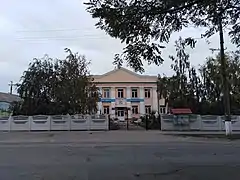 School of Music, General Kurkchi Street, Sartana, 2020
School of Music, General Kurkchi Street, Sartana, 2020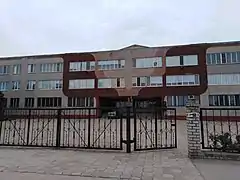 Sartana School no. 8, Partyzanska St, 2020
Sartana School no. 8, Partyzanska St, 2020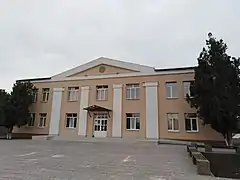 Tamara Katsa House of Culture, Chelyuskintsiv Street, Sartana, 2020
Tamara Katsa House of Culture, Chelyuskintsiv Street, Sartana, 2020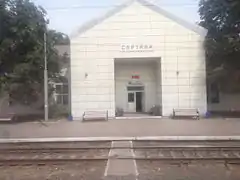 Sartana Station
Sartana Station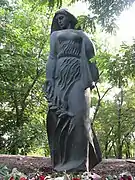 Memorial - Mass grave of Soviet soldiers of the Southern Front
Memorial - Mass grave of Soviet soldiers of the Southern Front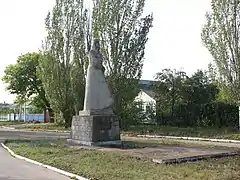 Memorial - Mass grave of the Heroes of the Civil War
Memorial - Mass grave of the Heroes of the Civil War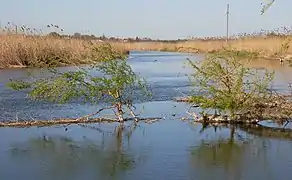 Kalmius River, Sartana
Kalmius River, Sartana
References
- Чисельність наявного населення України на 1 січня 2022 [Number of Present Population of Ukraine, as of January 1, 2022] (PDF) (in Ukrainian and English). Kyiv: State Statistics Service of Ukraine. Archived (PDF) from the original on 4 July 2022.
- "Ukraine's Greek village of Sartana: The persecutions, the war and the thirst for Greek education". Greek City Times. 6 March 2022. Retrieved 28 March 2022.
- "Churches of Sartana". Old Mariupol. Retrieved 28 March 2022.
- "Zaporizhzhia: A History of Mariupol, Ukraine, since the 16th Century". Brewminate. 24 March 2022. Retrieved 28 March 2022.
- "Presentation of CDs". HFCOdessa. Archived from the original on 2012-04-18. Retrieved 28 March 2022.
- "Local Human Rights Index in the Village of Sartana, Donetsk Region" (PDF). National Human Rights Index. Retrieved 28 March 2022.
- "Museum of the History of the Greeks of the Azov Region". Misto Mariupol. Retrieved 28 March 2022.
- Newsroom. "6 ethnic Greeks dead in Ukraine: Mitsotakis, Tsipras react | eKathimerini.com". www.ekathimerini.com. Retrieved 2022-03-01.
- "Greece summons Russian envoy after bombing kills 10 nationals". www.aljazeera.com. Retrieved 2022-02-28.
- Georgiopoulos, George (2022-02-26). "Greece says 10 expats killed in Ukraine, summons Russian ambassador". Reuters. Retrieved 2022-02-28.
- ""Save Us": Address of the President of the Federation of Greek Communities of Ukraine from a bomb shelter". Athens News. 14 March 2022. Retrieved 28 March 2022.
- "At Least 10 Greeks Killed in Russian Attacks at Mariupol, Ukraine". GreekReporter.com. 2022-02-26. Retrieved 2022-03-01.
- "Russian Forces Capture Ethnic Greek Village Of Sartana (Mariupol) From Ukrainian Army And Azov Battalions — Greek City Times". Greek City Times. 2022-03-02. Retrieved 2022-03-01.